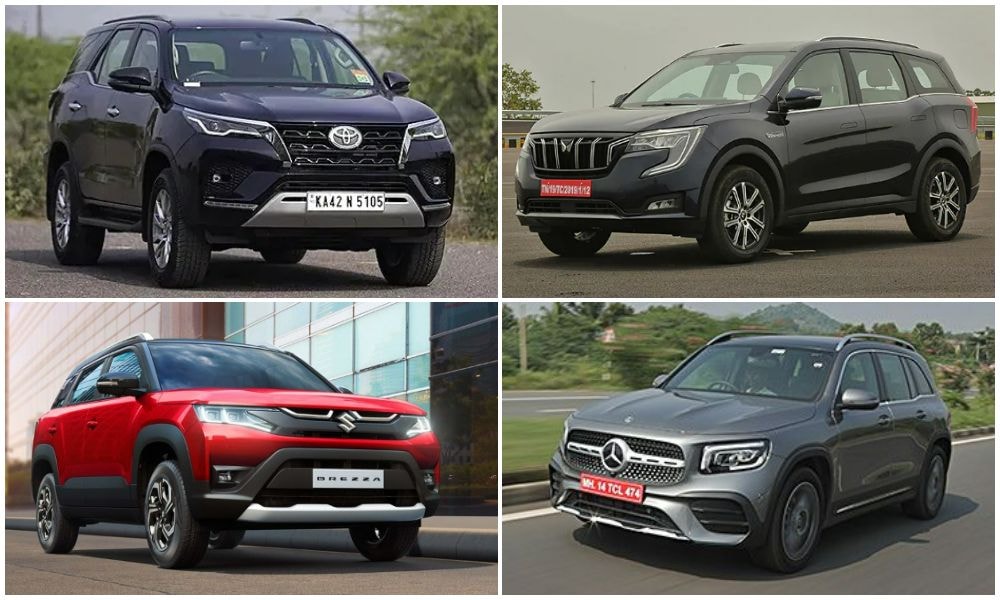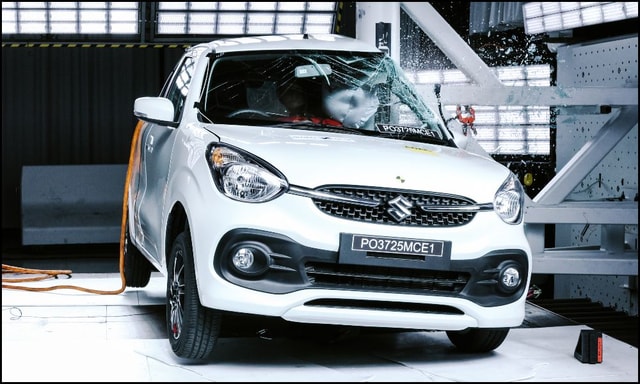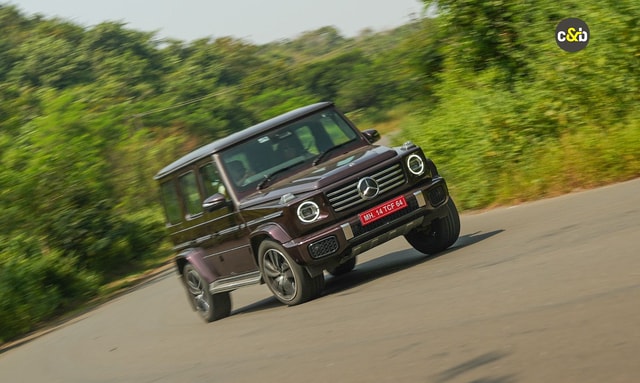GST On SUVs: Which Models Would Qualify For The Highest Rate Of Tax

- SUVs need to meet size, displacement and ground clearance criteria for GST rate
- Compact and subcompact SUVs to not attract highest tax rate
- SUVs need to be over 4m long, have over 1500 cc engines and sit 170mm off the ground
Taxes make up a major chunk of new car prices when the time comes to buy. Taxes on vehicles vary based on a variety of factors ranging from the body style, engine under the bonnet, length, price and more. In its most recent meeting, the GST council looked to provide some clarity on what cars will qualify as SUVs under the ambit of GST for the highest level of tax. SUVs in India have ranged from the subcompact (sub 4m segments) up to full-size luxury five- and seven-seat SUVs so various models could be affected differently.
First, let’s look at what qualifies as an SUV in the purview of GST. The GST Council says that for a vehicle to qualify as an SUV it should e popularly referred to as an SUV, have a length of over 4,000 mm, have an engine capacity greater than 1500 cc and have a ground clearance of greater than 170mm. Vehicles meeting all these criteria qualify as SUVs in the eyes of the GST laws and will attract the highest rate of tax ie 28 per cent GST and 22 per cent cess or about 50 per cent tax total. Vehicles not meeting these criteria will attract lower rates of cess over and above the 28 per cent GST in line with the current GST rules.
SUVs need to meet three criteria to qualify for the highest tax slab under GST as per latest clarification.
Here we look at how the SUVs on sale in India could be affected by this new ruling.
Keeping all four criteria in mind, none of the subcompact SUVs on sale in India should fall under the bracket of SUVs for GST. All models in this segment sit under the 4-metre mark and feature engines under the 1500cc mark thus not meeting two of the criteria that qualify them as SUVs.
Moving up a segment, SUVs such as the Creta, Seltos, Kushaq, Taigun, Astor, Grand Vitara and Urban Cruiser Hyryder too don’t meet all the criteria to qualify for SUVs. While all models here exceed the four-metre mark, engine capacities still fall below the 1500cc mark thus meaning that these models should not be taxed under the highest taxable bracket.
Interestingly the Thar does not meet the definition of an SUV as laid out by the GST council. While it meets the criteria for an engine over 1500 cc, ground clearance of over 170 mm and is popularly identified as an SUV, it does not meet the 4-metre mark. The current Thar measures in at 3985 mm meaning it does not meet the size criteria.
Most compact SUVs don't meet all criteria though larger models like the XUV700, Scorpio-N and Hector will qualify.
The Scorpio, Classic, Scorpio and XUV700 meet all four criteria and thus will attract the highest tax levels.
Sticking to the mid-size segment things get interesting with models such as the Alcazar and Hector. The petrol Alcazar meets all the requirements to be taxed under the highest slab of GST and cess while the diesel model does not qualify – the 1.5 diesel has a sub-1500 cc displacement. The Hector is in a similar boat with the diesel meeting the SUV criteria requirements while the petrol is sub-1500 cc and does not meet the requirement.
Tata’s Harrier and Safari meet all the criteria to qualify for the highest tax rate, as does the Hyundai Tucson. The Jeep Compass meanwhile will see the diesel attract the highest tax rate with the petrol not meeting the engine capacity criteria. The Meridian will also attract the highest tax rate.
Some models qualify for the highest tax slab for one of the engine options but not the other; Compass diesel meet all criteria while petrol doesn't meet displacement requirements.
Moving to the full size-seven seaters such as the Toyota Fortuner, MG Gloster and Isuzu MU-X, all qualify for the highest tax bracket.
Shifting to the more premium segments the BMW X1, Audi Q3 and Volvo XC40 qualify for the highest tax bracket. The GLA diesel also meets all criteria though the petrol should not attract the highest cess as it features a sub-1500 cc engine. The new GLB too sits in a similar category.
Moving a segment higher, models such as the GLC, X3, Q5, XC60, F-Pace and Macan fall within the ambit of the highest tax slab as do larger luxury SUVs such as the GLE, Grand Cherokee, X5 and Q7. Full-size models such as the Mercedes GLS and BMW X7 too will attract the highest tax slab.
It remains to be seen if there may be any amendments to the ruling for vehicles that attract the highest GST in select variants.
Trending News
 3 mins readWill The Kawasaki W230 Be Launched In India?
3 mins readWill The Kawasaki W230 Be Launched In India?
Latest News
 car&bike Team | Dec 23, 2025India Bike Week 2025 In Pictures: Highlights From Edition 12The 12th Edition of IBW was held on December 19 and 20, and if you missed this year’s festival, here is a recap of all that happened.3 mins read
car&bike Team | Dec 23, 2025India Bike Week 2025 In Pictures: Highlights From Edition 12The 12th Edition of IBW was held on December 19 and 20, and if you missed this year’s festival, here is a recap of all that happened.3 mins read Amaan Ahmed | Dec 23, 2025Tata To Enter Rs 40 Lakh Passenger Car Market With First Avinya Electric SUV In End-2026Set to be one of three EV launches from Tata Motors next year, the first in the Avinya series of electric vehicles will catapult the Pune-based carmaker into uncharted market territory, as it will be the most expensive Tata yet.1 min read
Amaan Ahmed | Dec 23, 2025Tata To Enter Rs 40 Lakh Passenger Car Market With First Avinya Electric SUV In End-2026Set to be one of three EV launches from Tata Motors next year, the first in the Avinya series of electric vehicles will catapult the Pune-based carmaker into uncharted market territory, as it will be the most expensive Tata yet.1 min read car&bike Team | Dec 23, 2025Will The Kawasaki W230 Be Launched In India?Kawasaki India has teased the W230 on its Instagram handle, indicating that the Kawasaki W230 may be in consideration for a launch in India.3 mins read
car&bike Team | Dec 23, 2025Will The Kawasaki W230 Be Launched In India?Kawasaki India has teased the W230 on its Instagram handle, indicating that the Kawasaki W230 may be in consideration for a launch in India.3 mins read Jaiveer Mehra | Dec 23, 2025Suzuki Fronx Secures One Star Safety Rating In ANCAP Crash Tests As Rear Seatbelt Fails During TestingThe Fronx scored less than 50 per cent points in both, adult and child occupant protection categories.1 min read
Jaiveer Mehra | Dec 23, 2025Suzuki Fronx Secures One Star Safety Rating In ANCAP Crash Tests As Rear Seatbelt Fails During TestingThe Fronx scored less than 50 per cent points in both, adult and child occupant protection categories.1 min read car&bike Team | Dec 23, 2025Final Jaguar F-Pace Rolls Of The Line: Production EndsThe Jaguar F-Pace marks the end of the brand’s internal combustion lineup, as the final model rolls off the line.2 mins read
car&bike Team | Dec 23, 2025Final Jaguar F-Pace Rolls Of The Line: Production EndsThe Jaguar F-Pace marks the end of the brand’s internal combustion lineup, as the final model rolls off the line.2 mins read car&bike Team | Dec 22, 2025Maruti Suzuki Celerio Secures Three-Star Rating In Global NCAP Crash TestsSix airbags-equipped model secured a three-star adult and two-star child occupant protection rating; the dual airbag model scored a two-star rating.3 mins read
car&bike Team | Dec 22, 2025Maruti Suzuki Celerio Secures Three-Star Rating In Global NCAP Crash TestsSix airbags-equipped model secured a three-star adult and two-star child occupant protection rating; the dual airbag model scored a two-star rating.3 mins read
 Jafar Rizvi | Dec 24, 2025MG Windsor EV 38 kWh Long-Term Report: IntroductionThe Windsor EV has joined our garage, and before it settles into daily duty, I took it out to get a sense of what living with an electric car is like.4 mins read
Jafar Rizvi | Dec 24, 2025MG Windsor EV 38 kWh Long-Term Report: IntroductionThe Windsor EV has joined our garage, and before it settles into daily duty, I took it out to get a sense of what living with an electric car is like.4 mins read Seshan Vijayraghvan | Dec 23, 20252026 Kia Seltos Review: Formula Is Spot On, But Is The Timing Right?The 2nd-gen Kia Seltos has arrived, but it has the challenge of facing strong rivals like the Victoris and Sierra. The question is simple - Does it still have what it takes?9 mins read
Seshan Vijayraghvan | Dec 23, 20252026 Kia Seltos Review: Formula Is Spot On, But Is The Timing Right?The 2nd-gen Kia Seltos has arrived, but it has the challenge of facing strong rivals like the Victoris and Sierra. The question is simple - Does it still have what it takes?9 mins read Seshan Vijayraghvan | Dec 22, 20252026 Tata Harrier & Safari 1.5 Hyperion Review: By The Power Of Petrol!The new Tata Harrier and Safari petrol packs a new 1.5-litre TGDI Hyperion engine, but is it an ideal alternative to the diesel version?7 mins read
Seshan Vijayraghvan | Dec 22, 20252026 Tata Harrier & Safari 1.5 Hyperion Review: By The Power Of Petrol!The new Tata Harrier and Safari petrol packs a new 1.5-litre TGDI Hyperion engine, but is it an ideal alternative to the diesel version?7 mins read Bilal Firfiray | Dec 19, 2025Maruti Suzuki e-Vitara Review: Worth The Wait?After a long wait, the first-ever electric Maruti Suzuki is here. It’s the e-Vitara, and it comes with a few promises. But arriving this late, is it worth the wait? Or is it a case of too little, too late?9 mins read
Bilal Firfiray | Dec 19, 2025Maruti Suzuki e-Vitara Review: Worth The Wait?After a long wait, the first-ever electric Maruti Suzuki is here. It’s the e-Vitara, and it comes with a few promises. But arriving this late, is it worth the wait? Or is it a case of too little, too late?9 mins read Bilal Firfiray | Dec 18, 2025Mercedes-Benz G450d: The Subtle Power of EvolutionThe Mercedes-Benz G 450d evolves subtly with more power, improved efficiency, and modern tech, while staying true to the timeless G-Class design. And character.4 mins read
Bilal Firfiray | Dec 18, 2025Mercedes-Benz G450d: The Subtle Power of EvolutionThe Mercedes-Benz G 450d evolves subtly with more power, improved efficiency, and modern tech, while staying true to the timeless G-Class design. And character.4 mins read































































































































